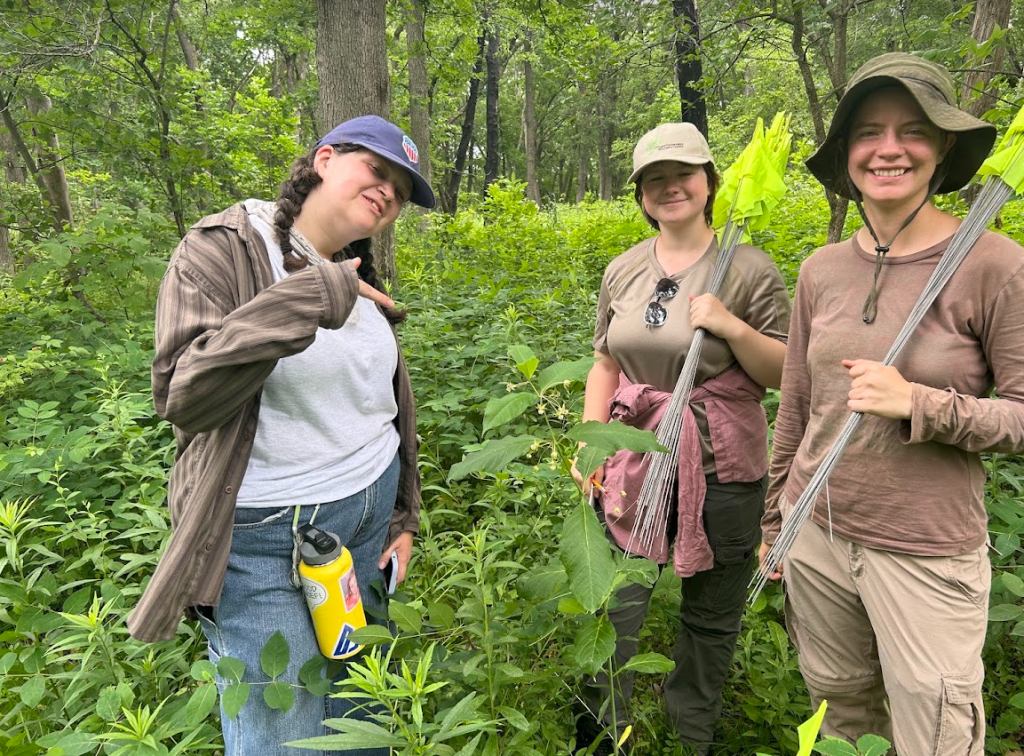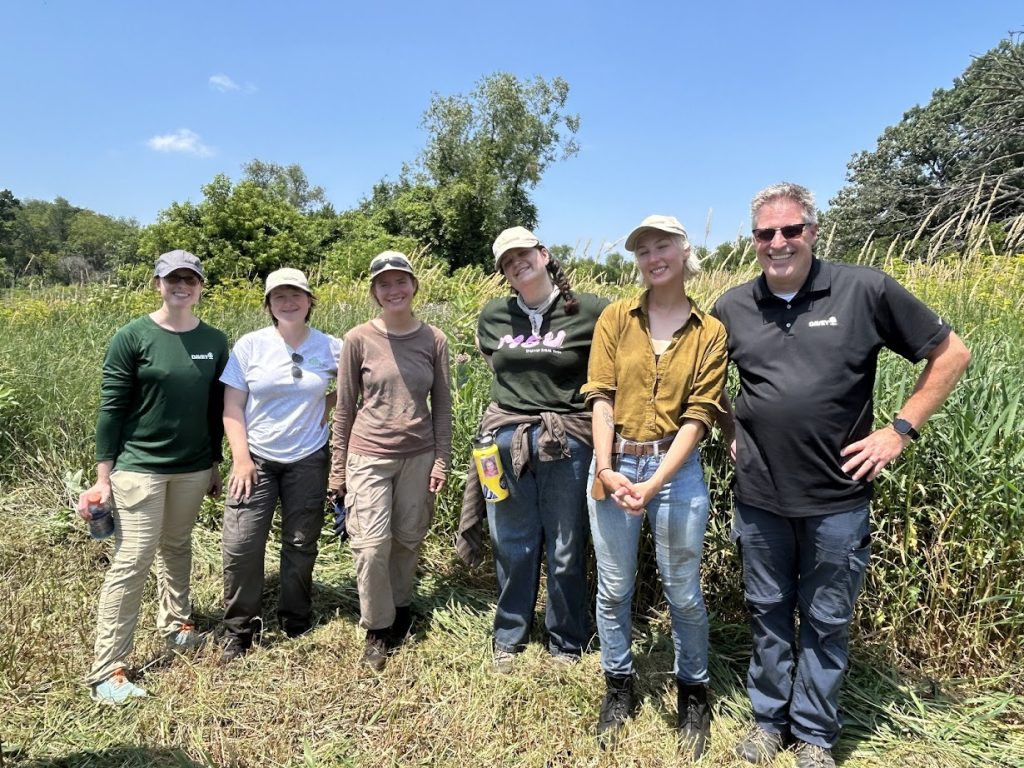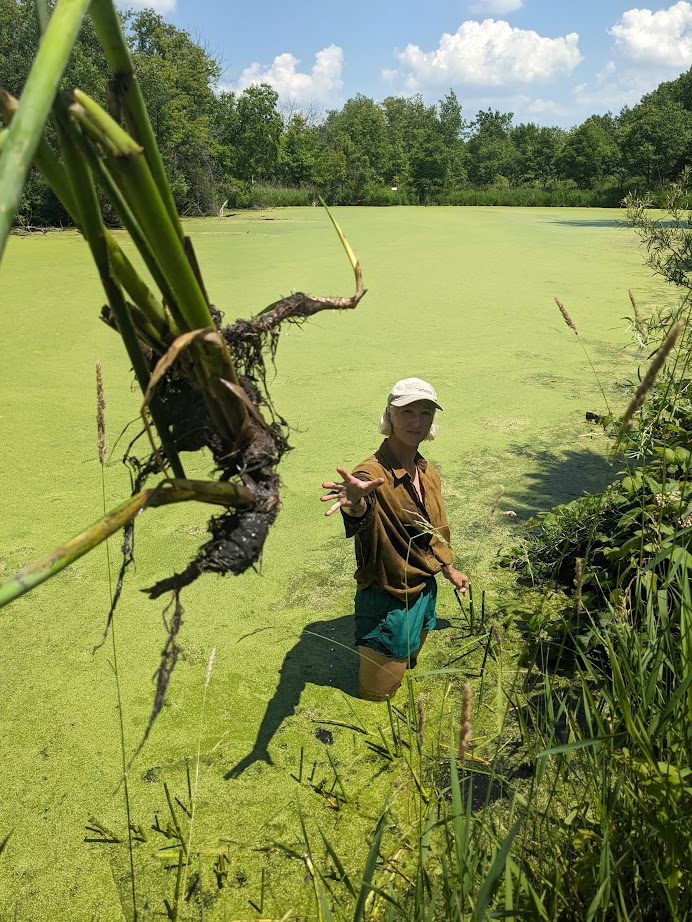
Adventures in Conservation – CLIP 2024 Week 4
This week’s blog is written by CLIP intern, Gia. I am a sophomore at Michigan State University studying environmental studies and sustainability, and with each new week here at CLIP I am delighted to gain more and more knowledge within the realm of ecology!
We began our fourth week the right way by working on some invasive parsnip removal at Gateway Park in Harvard. Even though we started our day early hoping to avoid the heat, the sun had other plans. Using our parsnip predators we got straight to work hacking at the stems of the parsnip in order to make the removal process easier. Despite the heat beating down on us, we still managed a lot of progress (thanks to our handy electrolytes and cooling towels)! Eventually we arrived at our next destination- TLC’s restoration ecologist Megan’s pond. Here, we began our transplanting process for bulrush from Megan’s pond to Hennen Conservation Area.
The first part of the process was to remove the bulrush and transfer it into buckets for easy transportation. So, while I stayed ashore gathering the bulrush and placing them into buckets, Emma, Oliver, and Emily alongside Megan removed the bulrush by making sure they were really getting near the roots and working them out of the rocks they had grown between. The pond was a refreshing and cool change of pace after working in the blazing sun earlier in the day. Once all of our buckets were full, we dried off and headed to Hennen to give the bulrush a new home. With only a bit of time left in our day we planted what we could of the bulrush into Hennen’s pond and moved the rest to a bigger kiddie pool until we could plant again.
 Tuesday we headed to Barefoot Ridge to monitor a plant of concern (POC). We tackled this by splitting into two teams, one taking the left side of the trail and the other taking the right. On each team we had a person using a GIS tool (to help navigate us toward previous points from past years to check on how the POC was doing in that area – as well as mapping any new areas we discovered), a person counting the amount of flowering POC we came across, and a person counting the amount of vegetative we came across as well. As we monitored we placed flags to make sure we didn’t miss mapping any new vegetation we came across and to help map out larger areas of vegetation. At the end of our monitoring we had concluded that the population of the POC had increased in comparison to previous years! All of the information we gathered was condensed and submitted to be used as potential data.
Tuesday we headed to Barefoot Ridge to monitor a plant of concern (POC). We tackled this by splitting into two teams, one taking the left side of the trail and the other taking the right. On each team we had a person using a GIS tool (to help navigate us toward previous points from past years to check on how the POC was doing in that area – as well as mapping any new areas we discovered), a person counting the amount of flowering POC we came across, and a person counting the amount of vegetative we came across as well. As we monitored we placed flags to make sure we didn’t miss mapping any new vegetation we came across and to help map out larger areas of vegetation. At the end of our monitoring we had concluded that the population of the POC had increased in comparison to previous years! All of the information we gathered was condensed and submitted to be used as potential data.
The second half of our day was dedicated to planning out an environmental lesson for the Youth and Family Center of McHenry County (YFC). We drove up to Moraine Hills State Park and scoped out the site and trails where we would be with the YFC kids and devised a plan. Emily had the bright idea to paint rocks as our activity, along the lesson theme of good bugs and bad bugs and their jobs in our ecosystem. For example, a spongy moth is a bad bug because it decays our oak trees, while an earthworm is a good bug because it is a decomposer and aerates soil. After checking out Moraine Hills we headed back to Hennen where we wrote up our lesson and figured out the small details to make our lesson and activity run smoothly.
 Just like that our first workday was finally here! We met volunteers at Crowley and helped them out by hauling sticks and brush out of the way of their chainsawing and invasive removal. There was lots of buckthorn removed, as well as some box elder and honeysuckle. At the end we had a huge clearing that looked like a campsite. Throughout our workday we enjoyed delicious snacks made by a volunteer and a lunch with some volunteers at the end as well! We had a great time getting to know them and we were glad we could finally help them out.
Just like that our first workday was finally here! We met volunteers at Crowley and helped them out by hauling sticks and brush out of the way of their chainsawing and invasive removal. There was lots of buckthorn removed, as well as some box elder and honeysuckle. At the end we had a huge clearing that looked like a campsite. Throughout our workday we enjoyed delicious snacks made by a volunteer and a lunch with some volunteers at the end as well! We had a great time getting to know them and we were glad we could finally help them out.
Later, we had a Zoom meeting with Dave Holman, GIS expert, who gave us a wealth of knowledge on GIS and its value. He showed us what good examples of maps look like and emphasized the importance of accessibility for your audience. One example Dave showed us was the Illinois Prescribed Fire Council’s prescribed burn map. Seeing the prescribed burns map was super interesting because the map was organized by giving each year a different color and when you clicked on a burn site you can see when it was burned, who was burning it, and the acreage of the site. Allowing the public to have access to information like this can help make things such as prescribed burns more normalized and less scary to the public, which I think is very neat.
My favorite day this week was Thursday! Not only did we get to sleep in but we kicked it off with some monitoring at Thompson Road Preserve with TLC Board Member Randy Schietzelt. While monitoring I took note of all the different plant species we saw. Other things we noticed were disturbances or any animal tracings, animals we had come across, and filling out a monitoring form specifically looking at invasive species on the property, as well as any significant notings. On top of all of this we made sure to take pictures of our significant findings to look back at and reference later. While the Thompson Road property is over 300 acres, we still managed to get a lot done. Right as rain began to drizzle is when we got back to our car and headed to a restaurant to compile our data.
 After eating a yummy dinner we drove out to Zion to meet Kathleen Garness who is a very well-known botanical artist. We met Kathleen at Hosah Preservation Area which is a remnant prairie, meaning it is an undisturbed area. Hosah was gorgeous and filled with many unique plants we don’t normally see in McHenry such as Indian Paintbrush and whorled milkweed. Kathleen also left us parting gifts including a handmade notebook and some utensils such as a ruler, colored pencils, erasers, and a pencil sharpener to draw with, which we appreciated a ton and are super excited to use in our own time.
After eating a yummy dinner we drove out to Zion to meet Kathleen Garness who is a very well-known botanical artist. We met Kathleen at Hosah Preservation Area which is a remnant prairie, meaning it is an undisturbed area. Hosah was gorgeous and filled with many unique plants we don’t normally see in McHenry such as Indian Paintbrush and whorled milkweed. Kathleen also left us parting gifts including a handmade notebook and some utensils such as a ruler, colored pencils, erasers, and a pencil sharpener to draw with, which we appreciated a ton and are super excited to use in our own time.


We rounded out our week with more parsnip removal at Tryon Creek Woods in Richmond. Thankfully, this time the heat was kinder to us and we were able to use our handy dandy parsnip predators once again to make significant progress at this site. After pulling lots of pesky parsnips, we had a nice lunch in the shade while being joined by Shawn Kingzette of Davey Tree. Shawn educated us on the signs of an unhealthy tree such as armillaria root rot and oak wilt. We then took a short walk around the site to view a few examples of the tree illnesses he had mentioned. It was interesting to see how different insects and factors such as climate change can impact the health of our trees! Finally, we went back to Hennen and finished transplanting the bulrush from Monday.
This week was filled with various new learning opportunities and experiences that have allowed us to grow so much and we are excited to share our continued growth throughout the rest of the summer as our passion for ecology and conservation grows alongside it!
